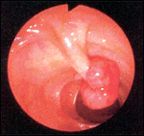Switch to 5-Year Follow-Up Could Still Prevent Colorectal Cancer Even After High-Risk Polyp Removal
Researchers in Germany have found that longer-term follow-up would still lower risk of colorectal cancer development among patients who had an adenoma detected and removed.
Researchers in Germany have assessed the risk of colorectal cancer (CRC) among patients who had an adenoma detected and removed, finding longer-term follow-up would still lower risk of CRC development. The population based case-control study is published in the Journal of Clinical Oncology.

Adenomatous polyp with long pedicle
“Risk of CRC was strongly and significantly reduced even between 3 and 5 years after detection and removal of high-risk adenomas,” according to Hermann Brenner, MD, of the University of Heidelberg in Heidelberg, Germany and coauthors. “Strong, significant risk reduction within 5 years after colonoscopic polypectomy was consistently seen among both women and men, and among both younger (less than 70 years) and older (greater than 70 years) patients.” This assessment included both patients with and without a previous history of CRC.
The study suggests that the low risk of detecting CRC within a 3-year time period can be extended to 5 years after a patient has had a polypectomy-even if the polyp removed was a high-risk adenoma.
While observational evidence suggests patients who had an adenoma removed from their colon during a colonoscopy may be more at risk for recurrence, studies assessing the risk of CRC after polyp removal is scarce. Colonoscopies are recommended as a primary screening tool but an outstanding question is the time to next surveillance for those patients who have had a polyp removed. In the United States, the current guidelines, updated in 2006, suggest those patients with a low-risk polyp need to be rescreened within 5 to 10 years, while those with a high-risk polyp should be followed up after 3 years. These recommendations are based on subsequent polyp, not CRC recurrence. The authors of the current study highlight overuse of colonoscopy screening for patients with a history of low-risk polyps, and underuse in patients with a history of high-risk polyps. Defining surveillance windows is important because as many as 30% of patients have a polyp removed upon their first colonoscopy.
Study Design and Results
All patients were from Germany, and their previous records of large-bowel endoscopies were reviewed. In total 2,582 patients with a history of CRC and 1,789 controls were analyzed in the study. Most participants were between 60 and 79 of age-the median age was 69 among patients, and 70 among the control group;160 patients and 264 controls had polyps detected and removed within the last 10 years of analysis. The typical patient who had a polyp removed was older and male compared to the study participants who had no polyps detected.
Those participants who had a colonoscopy within the last 5 years had a strongly reduced risk of CRC compared to participants with no previous colonoscopy. Relative risk reduction was 80% for participants who had had a polypectomy within a 3-year time period and 60% for those who had a polypectomy within a 3- to 5-year time period. Those patients who last had a colonoscopy 6 to 10 years ago had the same risk as participants who had no previous history of a colonoscopy.
When patients with a previous history of CRC were excluded, there was a risk reduction for those who had a polypectomy within 5 years, but it was not statistically significant compared to patients who went longer than 5 years between colonoscopies. There was a strong risk reduction for patients who had a colonoscopy within 5 years of a previous polypectomy that removed a high-risk polyp. Relative risk reduction was 60% for a subsequent colonoscopy within 3 years of the previous one, and 50% if the colonoscopy was within 5 years of the previous procedure.
The authors state that because they observed a similar risk of detecting a new polyp in the 3-year and 5-year time frame, the results challenge the “common understanding that a surveillance interval of 3 years is needed after detection and removal of high-risk adenomas, which is mainly based on studies that focused on risk of advanced adenomas following colonoscopic polypectomy.” Because most advanced adenomas progress slowly to CRC, extension of surveillance to a 5-year time frame is plausible. The authors highlight that while there is a low risk of CRC after polyp removal within a 5-year time frame, the risk returns beyond 5 years, even following a negative colonoscopy, likely due to an inherited risk component.
Overall, the authors propose that a shift toward more first-time colonoscopies is needed, and surveillance for those who have had a previous colonoscopy-even if a high-risk polyp was removed-could be extended to a 5-year interval. The time to subsequent colonoscopy could even be extended further for those who had a low-risk polyp or negative colonoscopy.